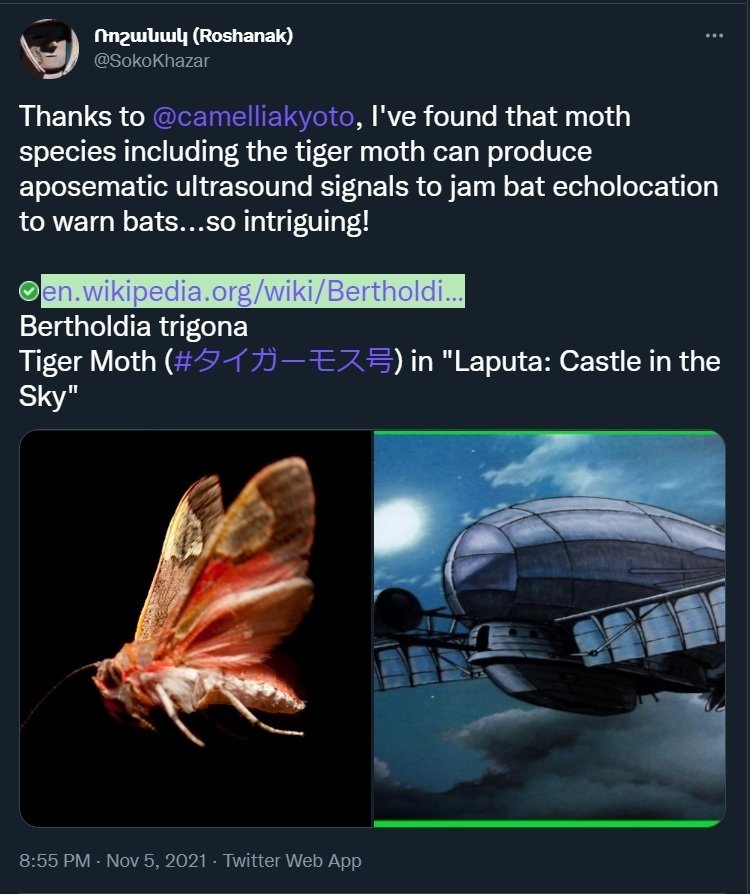
Echolocation
In the preface of "Algebraic Geometry" by Shigeru Iitaka published by Iwanami Shoten, Publishers (岩波書店) in 1976, the year I began my studies at an institute of technology, there's a mention to locust-shaped alien appearing in "The Atom Chronicles" アトム今昔物語 (by Tezuka Osamu), which may sound implausible for a textbook of Algebraic Geometry, but the preface continues : "The alien would check up on the tellurians in various ways...". This has to be interpreted in the context of studying algebraic varieties from various perspectives.
Much later, the idea occurred to me that one of the probing methods by the locust-shaped aliens might have been echolocation.
When I first heard the term "human echolocation" about 10 years ago, I mistakenly interpreted it as "eco location" - an inexpensive way to locate people without GPS🤔.
All nonsense aside, seriously it was incredible when I realized that human being could use echolocation, and the timing of when I heard about human echolocation coincided with when I was diagnosed with a mild visual field defect.
I am very afraid of losing the light. If I eventually lose the light completely, I am not confident that I will be able to overcome such a situation.
Whales & dolphins
Whales and dolphins, which lack external ears, rely on the echolocation technique in order to navigate and hunt in the dark. Much like shouting and listening for echoes, these animals emit high-pitched sounds that bounce off objects and reflect back at them, allowing them to map out their surroundings. The following article of Phys.org is quite intriguing:
Lately we have been hearing about mass strandings of whales, which is a complicated event... Here's another article by Phys.org :
Echolocation Jamming Moths
3 years ago, while looking into moths in general, irrelevant to echolocation by bats, I came across tiger moth.
https://x.com/SokoKhazar/status/1456590890193940481

As juxtaposed in the above post in X (Twitter), the name "Tiger Moth" is also adopted in "Laputa: Castle in the Sky" by Studio Ghibli, and those who love that film must be able to recollect the scene where flaptters launched from Tiger Moth (Dola's airship) smoke Goliath, the military airship. So, the naming is very much appropriate.

Incidentally The English title of the film is "Castle in the Sky" because translating Laputa as a proper noun would make it an undesirable word in Spanish.
Back to tiger moth, here is a concise up-to-date article on jamming moths:
Here're two important points:
What was believed in the past is that tiger moths use sound to deter bats from eating them. However it is purposed to inform the bats that those moths excrete a bitter chemical therefore taste nasty. The use of signals to communicate that the insect tastes bad is a fairly common defense in moths and butterflies, one typical example being a bright color indicating that it's poisonous.
A study in 2009 (Corcoran, A.J., Barber, J.R., and Conner, W.E. (2009). Tiger moths jam bat sonar. Science 325, 325-327.) showed that the moths were actually jamming the bats' echolocation. The researchers silenced the moths, and the bats ate them up! The moths weren't startling the bats and they weren't warning them, either.
This seems to be one particular example of the phrase "Life finds a way" by Dr. Ian Malcolm (Jeff Goldblum) in Jurassic Park.
Header image credit: Vision Loss Alliance
https://www.vlanj.org/human-echolocation-how-it-works/
P.S. 48 years ago, I was utterly unable to understand the contents of the book that I mentioned in the beginning of this article. After I read "Algebraic Geometry and Arithmetic Curves" (by Qing Liu) in 2023 I finally found the book accessible.
